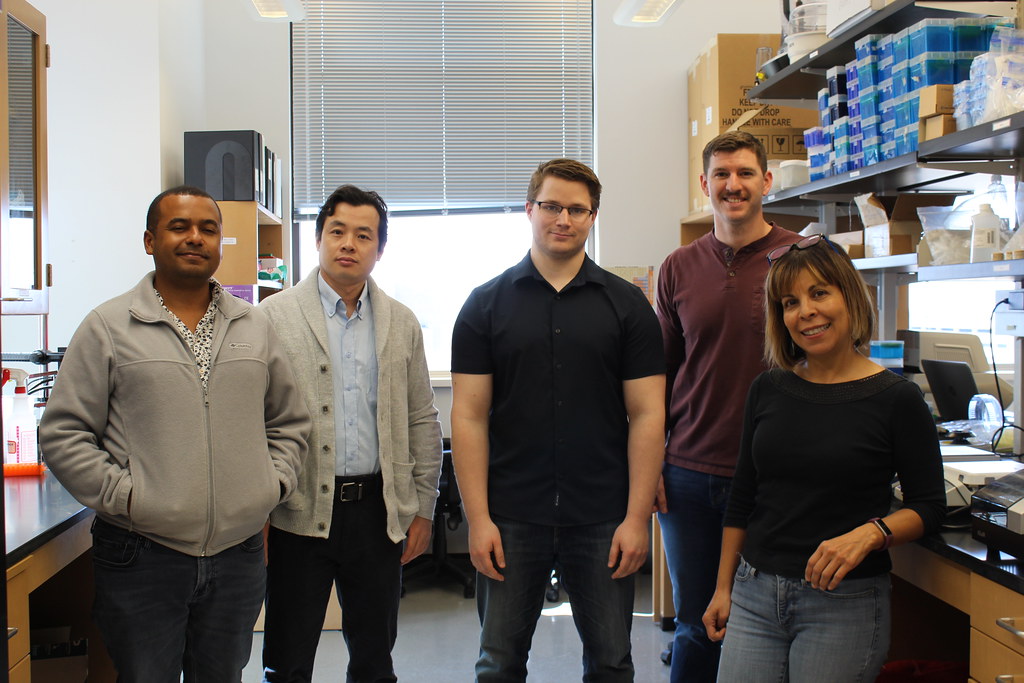Published on
 The Baker lab poses for a group photograph. The lab has been working with specialized pro-resolving lipid mediators in efforts to help patients with Sjögren’s Disease. Photo by Karly Balslew, Bond LSC
The Baker lab poses for a group photograph. The lab has been working with specialized pro-resolving lipid mediators in efforts to help patients with Sjögren’s Disease. Photo by Karly Balslew, Bond LSC
By Karly Balslew | Bond LSC
Saliva is probably not the first thing that comes to mind when we think about eating our favorite foods. The clear liquid washes away food debris and bacteria, and it plays a vital role in maintaining our dental hygiene and oral health.
You may take it for granted, but for patients with Sjögren’s disease, life without saliva is challenging.
“We’ve seen firsthand how patients suffer from Sjögren’s disease and what the consequences are in the oral cavity,” said Olga Baker, a Bond Life Sciences Center principal investigator studying the syndrome.
The autoimmune disease causes our body to attack the glands that produce tears and saliva. This destruction at the hands of our immune system causes dry mouth and dry eyes as it eventually kills the cells that perform this valuable service to our bodies. Without saliva, tooth decay and painful diseases like gingivitis are almost inevitable.
Sjögren’s disease affects approximately 4 million people in the United States. The severity of the disease varies in patients, but it destroys all exocrine glands and there is currently no cure. While the cause of the disease is still unknown, researchers are turning efforts to alleviate patient discomfort.
The Baker lab focuses on a class of drugs called specialized pro-resolving lipid mediators. These medications are derived from essential fatty acids and play an important role in decreasing inflammation and recovering salivary function.
Harim Tavares Dos Santos — a post-doctoral fellow in the Baker lab and lead author on a recent study of this drug —has seen success with restoring salivary functions with the specialized pro-resolving lipid mediator drug resolvin D1 (RvD1). Resolvins act as anti-inflammatory mediators and restores saliva flow rates. The lab will test a variety of drugs from the specialized pro-resolving lipid mediators’ class to see which one would yield the best results, but some receptors they affect within the salivary glands are unknown.
“The first step is to see if we know all the receptors for other drugs,” Tavares Dos Santos said. “Then, we test the different drugs to see which ones activate the receptor to possibly decrease inflammation and reach the goal of getting the saliva back.”
RvD1 activates the receptor ALX/FPR2 Tavares Dos Santos explains. This then triggers a signaling mechanism that promotes the survival of salivary gland cells and protects the cells tight junctions while increasing saliva secretion. Researchers used six human minor salivary from female subjects in this experiment to determine the expression of pro-resolving lipid mediators in patients with and without Sjögren’s syndrome.
Previously, the lab tested these drugs on mice models with Sjögren’s-like features and saw they can recover salivary function. However, researchers need more data to find other receptors that can maximize the positive response from the drug.
But mice aren’t the same as humans, and even when researchers test on humans it can be difficult to find patients with Sjögren’s disease willing to participate in the research.
“We don’t have a lot of literature in salivary glands to look for. Basically, what is known about resolvins and salivary glands is generated here in the lab,” Tavares Dos Santos said.
“Another challenge is that no one knows what causes the disease, so the research is mainly trial and error,” Baker said.
Baker explains that studies show people with Sjögren’s disease could have a genetic predisposition for it, but there are also environmental factors like viruses that could trigger the genetic components that lead to Sjögren’s disease.
“In the end, we want to create a drug that has all those properties to cure the patient so hopefully in the future, we can get a product on the market,” Baker said.
The Baker lab will present their progress with Sjögren’s syndrome at the 2023 Gordon Research Conference in Ventura, California. Both Baker and Tavares Dos Santos will co-chair the international conference that attracts researchers studying salivary glands and exocrine biology.
“This is a very important conference that will elevate Missouri,” Baker said. “The whole thing is really exciting.”
Olga Baker is a professor of Otolaryngology-Head and Neck Surgery and Biochemistry as well as a Bond Life Sciences Center principal investigator. Harim Tavares Dos Santos is a Bond Life Sciences Center post-doctoral fellow.